The Essence of 1920s Interior Design: 1920 Interior Design

1920 interior design – The 1920s was a transformative era in the world of interior design. The post-World War I era saw the rise of Art Deco and Bauhaus styles, which left an indelible mark on the aesthetic sensibilities of the time. The key characteristics of these movements, along with iconic furniture pieces from the period, define the essence of 1920s interior design.
The opulence of 1920s interior design is a testament to the era’s love for luxury and grandeur. Bold colors and geometric patterns were the order of the day, and no room was complete without a touch of the exotic. Black cat wallpaper was a particularly popular choice, adding a touch of mystery and intrigue to any space.
The intricate designs and deep hues of these wallpapers created a sense of drama and sophistication that was perfectly in keeping with the spirit of the times.
Art Deco Style in Interior Design
Art Deco, with its geometric forms, bold colors, and luxurious materials, became synonymous with the glamour and sophistication of the Roaring Twenties. Interiors embraced geometric patterns, such as zigzags and chevrons, often rendered in contrasting colors. Rich materials like marble, lacquer, and chrome added an opulent touch, while sleek lines and sharp angles exuded a sense of modernity.
Influence of the Bauhaus Movement on Furniture Design
The Bauhaus movement, with its emphasis on functionality and simplicity, had a profound impact on furniture design. Bauhaus furniture pieces were designed with clean lines, geometric shapes, and a focus on ergonomics. The use of tubular steel and bent plywood allowed for innovative and lightweight designs that were both aesthetically pleasing and practical.
The roaring twenties, an era of glamour and opulence, saw 1920 interior design flourish with plush fabrics, geometric patterns, and Art Deco accents. Yet, beneath the surface of sophistication lay a rebellious spirit that sought expression in unexpected ways. Enter skateboard wallpaper , a daring fusion of street culture and vintage elegance.
Its vibrant graphics and playful motifs injected a touch of youthful rebellion into the otherwise formal spaces, subtly hinting at the changing tides of the time.
Iconic 1920s Furniture Pieces
Some iconic 1920s furniture pieces that exemplify the era’s design sensibilities include:
- Wassily Chair by Marcel Breuer: This tubular steel and leather chair is a classic example of Bauhaus design, with its simple lines and geometric form.
- Barcelona Chair by Mies van der Rohe: This luxurious leather and chrome chair is known for its elegant curves and minimalist design.
- Zigzag Chair by Gerrit Rietveld: This iconic chair features a zigzag pattern in its wooden frame, showcasing the influence of Art Deco on furniture design.
Capturing the Opulence and Glamour of the Era

The roaring twenties was a period of economic prosperity and cultural change, which was reflected in the interior design of the time. Opulence and glamour were the order of the day, with rich materials, luxurious fabrics, and lavish lighting fixtures creating an atmosphere of sophistication and indulgence.
Rich Materials and Luxurious Fabrics, 1920 interior design
The use of rich materials and luxurious fabrics was a defining characteristic of 1920s interior design. Velvet, silk, satin, and brocade were all popular choices for upholstery, curtains, and bedding. These fabrics were often adorned with intricate embroidery, beading, or tassels, adding to the sense of opulence.
Furniture was typically made from dark woods such as mahogany, walnut, and ebony. These woods were often polished to a high sheen, giving them a luxurious appearance. In addition to wood, furniture was also made from metal, glass, and mirrored surfaces, which added to the overall glamour of the space.
Lighting Fixtures
Lighting fixtures played a vital role in creating the ambiance of a 1920s interior. Chandeliers, sconces, and table lamps were all used to provide both light and style. Chandeliers were often made of crystal or glass, and they were often adorned with intricate details. Sconces and table lamps were typically made of metal or glass, and they often featured geometric or Art Deco designs.
The use of lighting fixtures was not only functional but also decorative. The placement of lights could be used to create dramatic effects, such as highlighting a particular piece of furniture or creating a focal point in the room.
Color Palettes and Patterns
The color palettes of the 1920s were typically bold and vibrant. Bright colors such as red, orange, yellow, and green were popular, as were more muted colors such as beige, gray, and black. Patterns were also popular, and they often featured geometric or Art Deco designs.
The use of color and pattern in 1920s interior design was not only aesthetically pleasing but also symbolic. Bright colors were associated with optimism and prosperity, while muted colors were associated with sophistication and elegance. Patterns were often used to create a sense of movement and energy, which was reflective of the fast-paced lifestyle of the time.
Embracing the Modern and Functional
The 1920s witnessed a significant shift towards functionalism and simplicity in interior design. Inspired by the Bauhaus movement and the growing popularity of modern art, designers began to embrace clean lines, geometric shapes, and innovative storage solutions.
Space-Saving Designs and Innovative Storage
To accommodate the needs of increasingly urbanized lifestyles, designers sought to maximize space and create efficient storage solutions. Built-in cabinetry, modular furniture, and multi-purpose pieces became commonplace. Shelves and drawers were concealed behind sleek facades, creating a streamlined and uncluttered appearance.
Industrial Materials and Geometric Shapes
The influence of industrial materials and geometric shapes was evident in furniture and décor. Chrome, glass, and metal were used to create sleek and angular pieces. Art Deco motifs, characterized by bold geometric patterns and stylized curves, became popular in textiles, wallpapers, and lighting fixtures.
